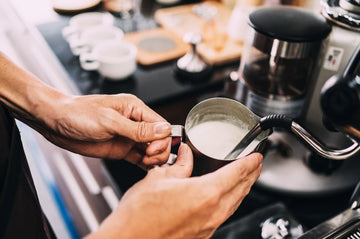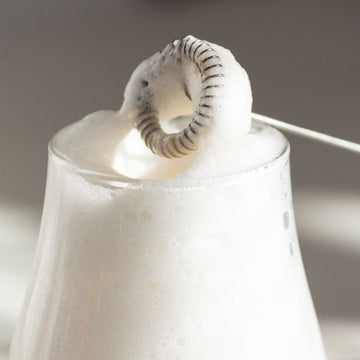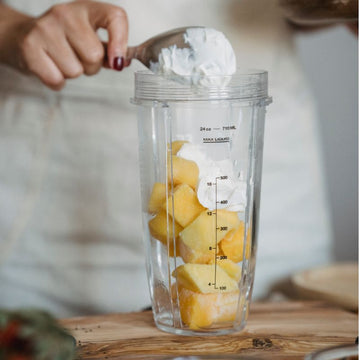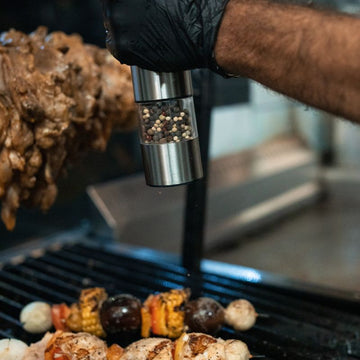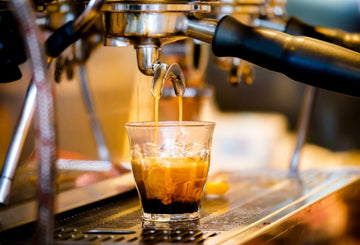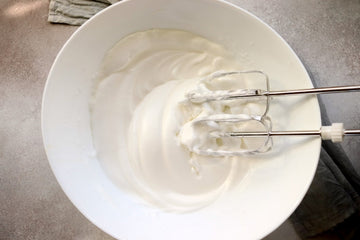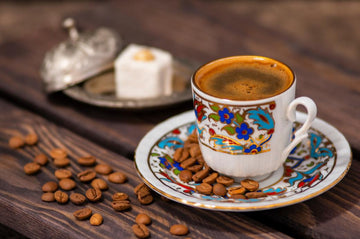A standard shot of espresso is exactly one ounce (about 30 milliliters). This is what most baristas refer to as a single shot, the foundational unit in espresso drinks. A double shot, also called doppio, is 2 ounces (around 60 milliliters).
How much caffeine is in a shot of espresso?
A single shot of espresso contains about ~60 milligrams of caffeine. A double shot doubles that to around 125 milligrams, though this can vary slightly depending on the beans and roast level.
How many grams of coffee are used per espresso shot?
A single shot typically uses 7 to 9 grams of finely ground coffee beans. And a double shot is, as the name suggests, double the amount. Specialty cafes might adjust this slightly based on extraction methods or flavor goals.
Ounces per type of espresso shot
-
Ristretto: ~0.5 to 0.75 ounces (15–22 ml): A "restricted" shot using less water for a bolder, syrupier flavor.
-
Normale: ~1 ounce (30 ml): The standard shot of espresso most people are familiar with.
-
Lungo: ~1.5 to 2 ounces (45–60 ml): A "long" shot with more water and a lighter body.
Each shot type adjusts the water-to-coffee ratio slightly, which changes the flavor and intensity. Now that the numbers are clear, let's take a closer look at what espresso actually is.
What is espresso?
Espresso is a kind of concentrated coffee. It is brewed by forcing hot water through finely ground coffee under high pressure. The result is a small, strong shot. But with a rich flavor and a layer of crema. The crema is a golden foam on top that signals a well-extracted shot.
Espresso’s origin date back to the early 20th century Italy. The word espresso comes from the Italian term meaning "pressed out," referring to the brewing method. The first espresso machine was patented in Italy in 1901, and the process has been refined ever since.
If you’ve seen the episode of Conan in Italy, where he strolls into a café for a quick morning drink, that drink is espresso. Italians typically enjoy it hot, fresh off the machine, and usually standing at the bar before getting on with their day. Espresso isn’t a type of bean or roast, but a method: pressurized hot water pushed through finely ground coffee to make a concentrated shot. If you haven’t watched the video, drop everything and give it a few minutes. It’s worth it.
Unlike drip or pour-over coffee, espresso is brewed quickly. Typically, in under 30 seconds. Yet, a cup of espresso delivers a deep, bold flavor in a compact serving. It's the base for many coffee drinks, including lattes, cappuccinos, macchiatos, and americanos.
Despite its small size, espresso is considered the heart of modern coffee culture. Whether you're pulling a single shot at home or ordering a double shot at a café, espresso remains a precise and intentionally crafted drink.
How to make an espresso
Making espresso is about precision. While modern machines simplify the process, the foundation remains the same: hot water, high pressure, and finely ground coffee.
What you need
-
Espresso machine (manual, semi-automatic, or automatic)
-
Fresh coffee beans (medium to dark roast works best)
-
Burr grinder
-
Tamper
-
Filter basket (portafilter)
Step-by-Step
-
Grind the beans: Start with high-quality coffee beans and grind them finely, similar to table salt. An espresso requires about 18–20 grams of ground coffee for a double shot, and around 7–9 grams for a single shot.
-
Dose and tamp: Place the ground coffee into the portafilter. Then, tamp it evenly with firm pressure. The goal is a level, compressed puck that creates resistance for the water.
-
Brew: Lock the portafilter into the espresso machine. Water heated to about 190–200°F is forced through the coffee at 9 bars of pressure. A standard single shot takes about 25–30 seconds.
-
Check the shot: A good espresso has a dark body, a golden crema, and a strong aroma. The flavor should be balanced. Neither too sour nor too bitter.
While espresso machines come in many forms, containing manual lever, pod-based, or fully automatic, all their brewing principle is the same. And while it takes practice to dial in grind size, dose, and time, once mastered, espresso becomes one of the most rewarding coffee preparations.
Other types of coffee vs. espresso

Espresso is often seen as the foundation of many coffee drinks, but it's quite distinct from other brewing methods in both preparation and experience. The difference isn’t just in strength or size, it’s in how the coffee is extracted and what that does to flavor, texture, and caffeine content.
Brew method
Most other types, like drip coffee, French press, pour-over, or cold brew, use gravity or immersion and take significantly longer to brew.
Grind and dose
Espresso uses a finer grind and a smaller dose. A single espresso shot uses about 7–9 grams of coffee and produces about 1 ounce (30 ml) of liquid. Drip coffee uses a coarser grind and can require 15–18 grams or more per cup, but yields much more liquid.
Caffeine content
Espresso is more concentrated in caffeine per ounce. It’s about 63 mg per shot. But because it's consumed in small quantities, a typical 8 oz cup of drip coffee still contains more caffeine overall (about 90–120 mg). However, for a quick kick, espresso hits harder.
Flavor and texture
Espresso is bold, rich, and intense, often with a layer of crema that gives it a creamy mouthfeel even without milk. Other methods like pour-over or Chemex highlight clarity and brightness, while French press leans heavier and more robust due to the oils left in the cup.
Serving styles
Espresso is often served alone or as a base for drinks like lattes, cappuccinos, macchiatos, and Americanos. Other brewing styles are typically served straight and in larger volumes. They are meant for slower sipping rather than a quick, concentrated hit.
Espresso is a unique but fundamental coffee. With its own rules and rewards. Whether you prefer it neat or mixed with milk, understanding its differences helps you appreciate it more fully.

FAQs
Why do different cafes serve different espresso shot volumes?
Because espresso isn’t standardized globally. While 1 ounce (30 mL) is the general baseline for a single shot, the actual volume can vary depending on the café's style, the machine calibration, and regional preferences. Specialty cafés often lean toward ristretto-style shots (0.5–0.75 oz), while others may stretch into lungo territory (1.5–2 oz) without labeling it explicitly.
Is a ristretto just a smaller shot, or is the flavor different too?
It’s both. A ristretto uses the same amount of coffee grounds but less water and a shorter extraction time. This results in a shot that's not only smaller in volume but also more concentrated and often perceived as sweeter and less bitter than a normale espresso. It’s not just a “mini espresso,” but a different balance of flavor compounds.
If espresso uses 7–9 grams of coffee, why does it feel stronger than a 12 oz drip coffee?
Because it’s more concentrated by design. Drip coffee may use more beans overall, but espresso extracts more solubles under high pressure in a fraction of the water volume. That concentration hits harder both in taste and in how the caffeine feels, even if total caffeine content isn’t always higher.
Do shot volumes matter in recipes like lattes or cappuccinos?
Yes, but not just for caffeine. A larger shot will dilute the milk’s texture and throw off the intended balance. Most espresso-based drinks are designed with a standard 1–1.5 oz shot in mind. If you're using a lungo in place of a normale, the final drink might taste flatter or more bitter than expected.
